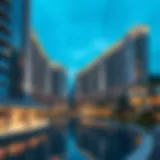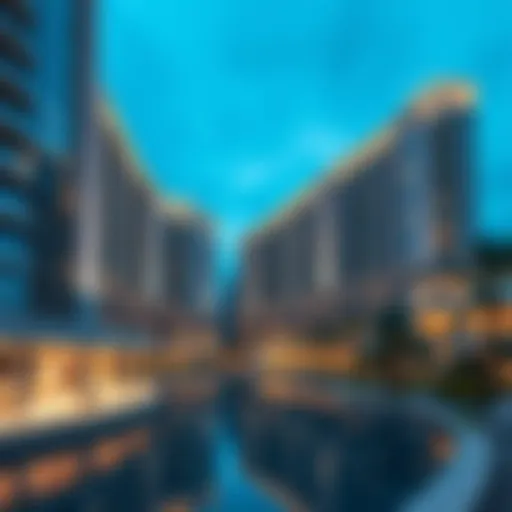Exploring the Cultural Evolution of Dubai's Opera District
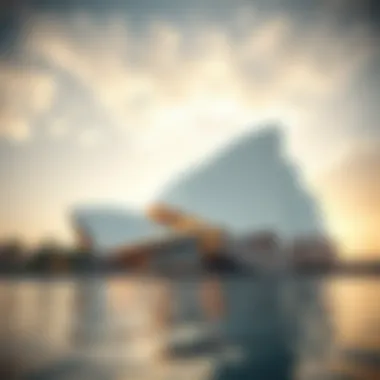

Intro
In the heart of Dubai lies the Opera District, a place that intertwines culture and elegance like few others in the world. This urban jewel, a stone's throw away from the iconic Burj Khalifa, is not merely a geographic area but embodies the spirit of artistic expression. The district has grown from its ambitious inception into a beacon of architectural beauty, housing the magnificent Dubai Opera among other artistic venues.
The Opera District pulsates with life, driven by a blend of historical significance and modern flair. Real estate dynamics here reflect a microcosm of Dubai’s broader economic landscape, attracting a diverse audience ranging from investors to homebuyers. Each corner of this district tells a story—be it through sleek skyscrapers or vibrant cultural festivals—making it essential for those with a stake in Dubai's real estate market to understand its intricacies.
This exploration will not only highlight the aesthetic and cultural landmarks but will also delve into the market trends and investment potential, offering a robust analysis for investors, real estate professionals, and prospective residents. With an eye on current trends and possible futures, one can grasp the full scope of what makes the Opera District a noteworthy focus in the realm of real estate.
Prelims to the Opera District
The Opera District is not just a geographical location in Dubai; it represents a vibrant crossroads of cultural experiences, architectural innovation, and economic potential. As we embark on this exploration of the Opera District, it’s vital to apprehend its significance in the broader context of Dubai’s evolving landscape. This area combines the whimsical charm of the arts with the pragmatic realities of real estate, making it beneficial for a range of stakeholders—be it investors, developers, or even homebuyers.
Understanding the Opera District is akin to looking through a high-powered telescope, revealing intricate details not easily visible at first glance. From its famous performances to its stunning skyline, every corner holds a story that ties back to the city’s ambition and vision. The Opera District stands out not only for its theatrical venues but also for its potential in terms of property value and investment opportunities. It is an area where culture meets commerce, fostering both artistic expression and economic growth.
Overview of the Opera District
Nestled in the heart of Dubai, the Opera District is akin to a bustling stage where life plays out in dynamic hues. This area encapsulates the spirit of the city—vibrant, luxurious, and forward-thinking. Home to the iconic Dubai Opera, the district serves as a hub for theatrical performances and cultural events, attracting locals and tourists alike. The architecture in this zone reflects an interesting blend of modernity and tradition, mirroring Dubai’s overall character.
Visitors often find themselves captivated by the array of amenities that surround the Opera District, including fine dining establishments, boutique shops, and picturesque waterfronts. Moreover, the area is well-connected to public transport, making it easily accessible for everyone.
- Cultural richness: Home to performances ranging from opera to ballet and concerts, it acts as a canvas for artistic expression.
- Architectural marvels: The striking designs elevate the area’s profile, making it not just a place to visit but a landmark to admire.
- Economic potential: Strong demand for real estate and commercial space due to the influx of tourists and local activities.
Historical Context
To appreciate the Opera District in its current form, one must delve into its historical roots. Before the area became synonymous with culture, it was merely a part of Dubai’s expansive desert landscape. The groundwork for the culture-rich district was laid during the city’s ongoing transformation into a global powerhouse.
Through the years, the need for a dedicated cultural space became evident. Thus, the construction of Dubai Opera was initiated, representing not only the commitment to the arts but also an investment in the future. Established as a symbol of architectural and artistic ambition, Dubai Opera has now become a cornerstone around which the surrounding area has flourished.
Unlike many urban developments, the Opera District has been designed with a purpose— to create a cultural ecosystem that promotes and celebrates the performing arts. This vision positions the district as a beacon of creativity, encapsulating Dubai's essence as more than just a business hub, but a stage for global culture to unfold.
In essence, exploring the Opera District’s historical narrative reveals much about Dubai’s evolution, from a trading port to a melting pot of arts, culture, and innovation. Its past intricately weaves into the fabric of the present, making it an exciting prospect for prospective investors and residents.
Architectural Significance
Architectural significance in the context of the Opera District extends far beyond the mere aesthetics of the buildings. It encompasses the foundational role these structures play in shaping the cultural narrative of this vibrant area. The district is a living testament to the fusion of traditional motifs with cutting-edge modernity, exemplifying how architecture can be an emblem of local identity while also serving as a platform for international cultural exchange.
When we talk about architectural significance here, it’s vital to consider how these designs influence the perceptions of the district. The sleek lines of the skyscrapers contrasted by historical elements create a unique visual tapestry. This blend not only attracts passersby but also plays a pivotal role in establishing the Opera District as a cultural and social hub. Therefore, understanding the architectural aspects is crucial for not just investors but also for anyone looking to appreciate the intricate layers that make up this community.
Key Architectural Features
Within the Opera District, several remarkable features stand out. The Dubai Opera, for example, is a focal point with its sail-inspired silhouette reminiscent of the waves that caress waterfront promenades. Its multipurpose space accommodating opera, ballet, and concerts demonstrates versatility, underscoring the integration of design with functionality.
- Use of Glass and Steel: Many structures incorporate vast glass façades that reflect the surrounding skyline, promoting a sense of openness. This not only allows natural light to flood spaces but also minimizes energy usage.
- Rooftop Gardens: Architecturally advanced buildings often feature rooftop gardens which provide green spaces amidst the hustle and bustle of urban life. These not only enhance aesthetic appeal but also improve air quality.
- Unique Facades: Take for instance the building designs that mimic natural forms, like the flowing curves that resonate with desert landscapes, creating a seamless transition between nature and architecture.
Such features contribute to an identity that is uniquely tied to the essence of Dubai while providing insights into sustainable urban living.
Influences and Styles
The architectural landscape of the Opera District reflects a melange of styles. This eclecticism is paramount for understanding its appeal.
- Middle Eastern Traditions: Elements of Islamic architecture emerge throughout the district, observable in intricate geometric patterns and calligraphic motifs. These not only pay homage to cultural roots but also interlace contemporary designs with historical context.
- Postmodernism: A shift in trends brings a playful representation of forms and colors. Architects dabble with asymmetrical designs and unexpected materials, infusing life into public spaces.
- Global Styles: The influence of international architectural styles is apparent in several structures, showcasing how global aesthetics can harmonize with local traditions. Developers often collaborate with global architects, ensuring the designs reflect both local sensibilities and universal trends.
Sustainable Design Elements
Sustainable architecture in the Opera District plays a vital role in addressing environmental concerns while promoting modern living.
- Energy Efficiency: Structures are designed with solar panels and energy-efficient systems to minimize the carbon footprint. This is crucial in a city known for its extreme weather.
- Water Management Systems: Innovative designs incorporate systems that collect and recycle rainwater, ensuring water conservation in a region where it’s a precious resource.
- Sustainable Materials: Many buildings utilize materials with lower environmental impact, promoting sustainability from the ground up.
In essence, the architectural significance of the Opera District propels it into a new era of urban development. With an emphasis on environmental considerations, emotional resonance through cultural roots, and marrying the old with the new, the district stands as a blueprint for future developments in Dubai and beyond.
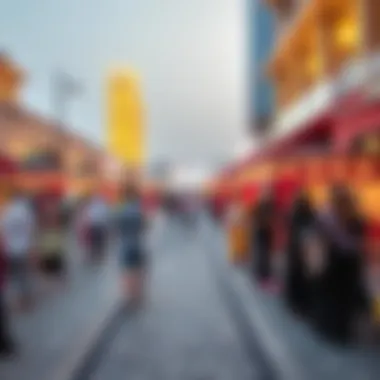

"Architecture is a visual art, and the buildings speak for themselves."
For further reading on architectural trends and sustainable design, consider exploring resources from Wikipedia, Britannica, or community discussions on Reddit related to urban architecture.
Cultural Impact
The cultural landscape of the Opera District is rich and varied, serving as a vital artery for the arts and community spirit. When one talks about cultural impact, it isn't just about performances or art exhibits, but rather how these elements intertwine with the everyday lives of residents and visitors alike. This area encapsulates a mosaic of creativity, community engagement, and ultimately, a catalyst for economic growth.
Performing Arts Venues
At the heart of the Opera District are its esteemed performing arts venues that attract international acclaim. The Dubai Opera stands out as an architectural marvel, designed to resemble a traditional dhow. This venue showcases a range of performances including opera, ballet, and concerts. With a capacity of over 2,000 seats, it is not just a theater but a cultural hub drawing in crowds from around the globe.
Some other notable venues include the Dubai Culture & Arts Authority and smaller local theaters that provide a platform for emerging artists. Together, they form a network of spaces where creativity flourishes. The accessibility of these venues encourages locals to explore various artistic expressions, enriching the overall cultural fabric of Dubai.
Annual Cultural Events
The Opera District is no stranger to celebration, hosting a plethora of annual events that highlight its cultural significance. For instance, the Dubai Arts Festival showcases local talents alongside international artists, creating an environment for cultural exchange. Through art walks, music festivals, and food fairs, residents and tourists alike participate in activities that reinforce a sense of community.
- Art Dubai is another prestigious event held here, inviting artists, collectors, and art lovers to engage with contemporary works from the region and beyond.
- Additionally, the Dubai International Film Festival draws cinephiles, making the area a nucleus of audiovisual creativity.
These events not only attract tourists but also provide local businesses an opportunity to thrive. The foot traffic generated aids cafes, shops, and markets in the area, fostering an environment where economic growth harmonizes with cultural expansion.
Role in Promoting the Arts
The Opera District plays a crucial role in promoting the arts not just as a commercial venture, but also as a community-building exercise. The district’s various initiatives often aim to democratize access to art, ensuring that people from all walks of life can participate. Furthermore, art education programs have been introduced in collaboration with local schools, fostering creativity among youth.
“An investment in knowledge pays the best interest,” said Benjamin Franklin, and this rings true in the Opera District as educational workshops and exhibitions invite residents to engage deeply with the arts.
Moreover, collaborative projects between art institutions and local government have bolstered funding for the arts, allowing for bigger productions and wider outreach. Through these measures, the Opera District not only highlights the significance of artistic expression but also acts as a driving force for sustained cultural investment in Dubai.
Real Estate Landscape
The real estate landscape in the Opera District is not just a matter of bricks and mortar. It embodies an entire lifestyle and cultural experience, attracting a diverse range of residents, tourists, and business professionals. This area is characterized by its proximity to world-class attractions and is a vibrant crossroads for various economic activities. The thriving real estate market here offers a unique blend of opportunities, presenting significant potential for investors and developers alike.
Property Types Available
In the Opera District, property seekers encounter a rich tapestry of options. From high-end apartments with sweeping views of the Dubai Fountain to lavish penthouses within luxurious skyscrapers, the choices cater to varied preferences and financial capabilities.
- Residential Units: These include spacious apartments, contemporary condos, and penthouses. Many offer amenities like rooftop pools and state-of-the-art gyms.
- Commercial Spaces: With a growing number of businesses setting up shop, commercial properties attract those looking to establish retail outlets or corporate offices.
- Mixed-Use Developments: These combine residential, hospitality, and retail spaces, fostering a dynamic community where residents can live, work, and play—all within arm's reach.
Market Trends and Prices
Keeping an eye on market trends in the Opera District reveals a narrative of growth and investment potential. Over recent years, property values have appreciated significantly, a trend projected to continue as the area gains more prominence.
- Average Property Prices: Prices tend to vary considerably based on property type and location within the district. As of the latest reports, luxury apartments can reach up to AED 3 million or more, while commercial spaces also command competitive pricing.
- Rental Yields: With a rising demand for rental units, yields in this region are remarkably attractive, providing potential returns that often surpass averages found in other parts of Dubai.
- Buyer Demographics: The buyer pool is increasingly diverse, ranging from expatriates seeking long-term residences to international investors captivated by the area’s potential for capital growth.
"The Opera District is a hotbed for innovation and luxury, making it a prime target for both investors and homebuyers."
Investment Opportunities
For investors, the Opera District offers a treasure trove of prospects. The confluence of cultural attractions and commercial growth positions this area prominently on the real estate map.
- Emerging Projects: Upcoming developments in the pipeline hint at continued appreciation in real estate value. Investors may want to consider pre-launch opportunities, which often present discounted pricing before the properties are fully realized.
- Cultural and Tourism Boost: Given the district’s cultural hub status, investors can tap into the burgeoning tourism market, attracting visitors year-round.
- Strategic Location: The area’s connectivity to major transport links enhances its appeal, thus presenting a compelling case for long-term investment.
The Opera District’s real estate landscape is vibrant and full of potential. By understanding the nuances of property types, market dynamics, and investment opportunities, stakeholders can make informed decisions that align with their goals.
Economic Factors Influencing Growth
Economic factors play a pivotal role in shaping the growth of the Opera District in Dubai. As a nexus of culture and commercial activity, the area is influenced by various dynamic elements that contribute to its development and attractiveness both for locals and international stakeholders. Understanding these factors is essential for investors, developers, and policymakers alike.
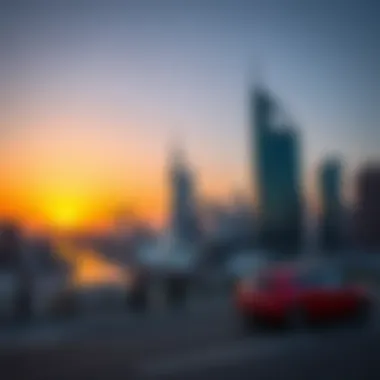

Impact of Tourism
Tourism is a driving force behind the economic vitality of the Opera District. With a rich tapestry of cultural offerings—ranging from world-class operas to art exhibitions—the district draws a diverse crowd from around the globe. Tourists not only experience the artistic offerings but also contribute significantly to local businesses, from hotels to restaurants. This influx creates a ripple effect.
For instance:
- Increased foot traffic leads to higher sales for retailers.
- Hotels benefit from a steady stream of guests attending events.
- Local artisans and performers find greater visibility and opportunity.
The Symphony of Lights, a spectacular view at the Dubai Opera, attracts many, making it a memorable part of their visit. This means that boosting tourism directly translates to economic growth, making it a cornerstone for the Opera District's economy.
"The cultural allure of the Opera District is a magnet for tourists, offering experiences that turn into memories, and memories into economic benefits.”
Government Initiatives
The commitment of local government bodies toward the Opera District's development is evident in various initiatives aimed at cultural promotion and urban enhancement. These initiatives include funding for infrastructure projects, grants for artists, and partnerships with international cultural entities. Moreover, policies that support the creative industries bolster an environment where art can flourish.
Some noteworthy initiatives include:
- Cultural grants to support local artists and performers.
- Infrastructure upgrades to improve accessibility, such as public transportation links.
- Public-private partnerships that bring in expertise from global entities in hosting events.
By aligning with national visions for innovation and culture, these initiatives foster an ecosystem that not only enhances the district's profile but also makes it more resilient economically.
Foreign Investment Regulations
The Opera District stands at the confluence of local charm and international appeal. Hence, foreign investment becomes a critical component of its economic strategy. Friendly regulations can attract international investors eager to tap into Dubai's burgeoning real estate market.
Understanding the legal landscape surrounding foreign investment in the Opera District is vital. Key elements to consider include:
- Ownership regulations, enabling foreign entities to invest in property.
- Tax incentives for international investors that encourage long-term commitment.
- Transparent legal frameworks, ensuring ease of business and reducing the friction in property transactions.
The accessibility of foreign investments not only enhances the capital inflow but also brings in diverse perspectives, adding layers of creativity and innovative solutions to the Opera District's growth trajectory.
Community Engagement and Development
Community engagement and development represent the lifeblood of the Opera District, intertwining its rich cultural fabric with the ambitions of its residents and stakeholders. This aspect not only promotes a sense of belonging but also encourages civic pride and active participation in the ongoing transformation of the district. When people feel they have a voice, there's a ripple effect that can lead to enhanced social cohesion, economic growth, and sustainable urban planning.
Local Affairs and Participation
Engagement at the local level is crucial for shaping the future of the Opera District. Residents and businesses alike must have platforms to express their views on developmental plans and city governance. Various community meetings and neighborhood events enable this kind of participation, fostering an environment where feedback isn’t just welcome but actively sought.
- These local gatherings often highlight issues such as noise control from events, traffic management during peak hours, and maintaining public spaces.
- By integrating a broad base of community opinion, developers and planners can make more informed decisions that reflect the diverse needs and aspirations of the district’s inhabitants.
Moreover, initiatives like neighborhood committees serve as channels for ongoing dialogue. They create opportunities for residents to connect with local representatives to voice concerns or propose ideas. This bottom-up approach can lead to innovations, like community gardens or public art projects, which enhance livability and engender a sense of ownership over shared spaces.
Social Infrastructure
Social infrastructure is another vital thread in the fabric of community engagement within the Opera District. This encompasses not just physical spaces, but the networks and systems that promote social interactions and support. Libraries, community centers, and recreational spaces contribute significantly to social connectivity and provide resources that cater to various demographics.
Consider the following:
- Community Centers: Act as hubs for workshops, cultural events, and social meetings. They bring together diverse groups and foster an inclusive atmosphere.
- Public Parks and Gathering Spaces: These areas facilitate informal contact between neighbors, allowing friendships and understanding to flourish in a natural setting.
- Educational Programs: Initiatives aimed at different age groups enhance knowledge, promote skill development, and encourage lifelong learning.
As residents engage with these facilities, they become more resilient and adaptive. Strengthened social bonds within the community lead to improved mental well-being and bolster grassroots movements that advocate for local issues, ultimately making the Opera District a thriving environment for its residents and a sought-after locale for investors.
"In a community where engagement thrives, the possibilities for growth and happiness are endless."
With a focus on local affairs and robust social infrastructure, the Opera District is set to become not just a cultural beacon in Dubai, but a dynamic, inclusive community where all voices contribute to a common future.
Challenges and Considerations
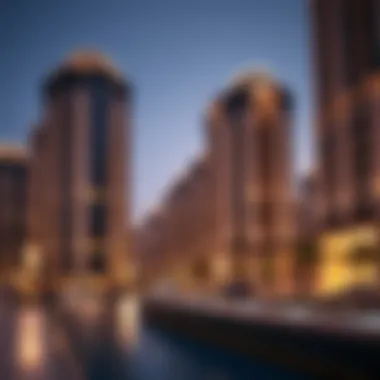

The Opera District, while a society thriving in culture and architecture, faces a unique set of challenges. Recognizing these hurdles becomes essential, especially for investors and stakeholders eyeing opportunities in the area. The dynamics at play involve a balance of rapid urban growth and respect for the heritage that defines this district. This section aims to shed light on crucial considerations that could influence decision-making in this vibrant locale.
Urban Development Challenges
Urban development within the Opera District is not without its hurdles. A primary concern is the pace of growth. As this area transforms with new constructions, maintaining an equilibrium between modern developments and historical aspects is vital. Overwhelmingly, the pressure from rapid urbanization can lead to a variety of consequences:
- Infrastructure Strain: Existing roads, public transport, and utilities may struggle to keep pace with an influx of new residents and businesses, leading to potential congestion and associated inconveniences.
- Environmental Concerns: With development, often comes disruption to the local ecosystem. Preserving green spaces and ensuring sustainable practices becomes critical to maintaining the district’s appeal.
- Zoning Regulations: Real estate developers often face challenges navigating complex zoning laws that govern the types of buildings that can be erected and the land use which can impact their investment plans.
Addressing these challenges involves collaboration between developers and urban planners to foster sustainable growth strategies that prioritize durability without forsaking the district’s unique identity.
Balancing Growth with Heritage
As development pressures mount, a fundamental question looms: how can the Opera District grow while honoring its rich heritage? The architectural narrative of the area is interwoven with historical significance. The following factors illustrate the importance of balance:
- Cultural Identity: The Opera District serves not only as a residential area but also as a cultural hub, where historical structures echo the past. Maintaining these landmarks is essential to preserving the neighborhood’s soul.
- Community Sentiment: Many residents have deep-rooted connections to local history. Any change that threatens to overshadow these sentiments could be met with strong opposition, complicating development initiatives.
- Tourism Impact: Heritage sites often attract visitors, contributing to local businesses. Striking a balance in development can ensure that tourism flourishes while protecting the sites that drew visitors in the first place.
Incorporating heritage preservation into urban planning can yield benefits that extend beyond the immediate community, enhancing the overall appeal of the Opera District and creating a lasting legacy for future generations.
"In the end, a developed area should tell a story that honors both its past and its future."
Navigating the complexities of urban development and heritage conservation requires a clear vision and cooperative efforts, ultimately leading to an Opera District that thrives on its past while embracing its future.
Future Outlook
The future of the Opera District stands as a testament to its progressive nature and strategic importance within Dubai's ever-evolving cityscape. As interest in urban living swells, this area is poised to become a focal point for those seeking cultural vibrancy alongside contemporary urban conveniences. Understanding future developments here is critical not only for stakeholders in the real estate market but also for anyone keen on grasping the dynamics of a rapidly modernizing society.
Predicted Developments
Several developments within the Opera District are anticipated to reshape its landscape. For instance:
- Expansion of Cultural Venues: With plans for additional theaters and galleries, cultural offerings are expected to multiply, attracting not only local audiences but also international visitors.
- Enhanced Transport Connectivity: Upcoming metro lines and public transport upgrades will likely improve access and spur economic activity, making the area more appealing to businesses and tourists alike.
- Green Spaces: Developers increasingly recognize the necessity of integrating green spaces into urban design. Parks and communal areas will create harmonious settings for residents and visitors, enhancing the overall quality of life.
These changes aim to create not just a place to live, but a vibrant community where art and nature intertwine seamlessly.
Long-term Real Estate Trends
Looking further into the future, the real estate trends within the Opera District present a fascinating picture. Challenges remain, as they always do, but there’s much to look forward to.
- Increased Property Values: As the Opera District matures and gains more recognition, property prices are likely to witness a steady rise. Investors should monitor these fluctuations closely to make informed decisions.
- Diverse Property Types: The market will continue to diversify, offering everything from luxurious high-rises to more affordable apartments. This variety will attract a broader demographic, including young professionals and families.
- Sustainable Development: The shift towards sustainable building practices is not just a fad; it’s becoming a fundamental aspect of property development. Expect more eco-friendly projects that meet the growing demand for environment-conscious living.
In essence, the Opera District is on the brink of a renaissance that combines cultural depth with modern living standards, ensuring its place as one of Dubai's most sought-after locales.
"The Opera District will not just be a location; it will be a lifestyle - a blend of culture, community, and modernity."
For more insights on urban developments and community initiatives, check out resources like Wikipedia or visit local forums on Reddit for ongoing discussions.
The End
The closing section of an article on the Opera District is not merely a wrap-up; it serves as a crucial synthesis of the insights gleaned throughout the narrative. This section is vital as it reiterates the multifaceted nature of the Opera District; a blend of cultural vibrance, architectural beauty, and economic potential. As such, the conclusion should encapsulate the significance of each element discussed, from community engagement to the architectural innovations that delineate this unique area.
Recap of Key Insights
Throughout the exploration of the Opera District, several salient points emerge:
- Architectural Marvels: The Opera District boasts striking designs, indicative of both modernity and cultural heritage. Buildings like the Dubai Opera reflect ambitious construction, resulting in not only functional spaces but also aesthetic triumphs.
- Cultural Epicenter: The area thrives on a calendar full of artistic events. These gatherings foster a sense of community and attract visitors, which is essential for local business vitality.
- Real Estate Dynamics: The property landscape is diverse, showcasing luxury residences, commercial venues, and mixed-use developments, indicating a buoyant market poised for growth.
- Sustainable Practices: There is an increasing focus on eco-friendly designs and construction practices in future developments, signaling a commitment to environmental stewardship.
"Understanding the Opera District is pivotal for anyone looking to invest, live, or simply engage with this dynamic space."
Final Thoughts on the Opera District
In closing, the Opera District stands as a testament to the confluence of art, architecture, and commerce in Dubai. The interplay of these factors creates an environment ripe for investment and cultural enrichment. It is imperative for stakeholders, be they real estate agents, investors, or developers, to grasp the implications of the shifts taking place within this neighborhood.
The future outlook appears promising, with anticipated developments likely to enhance both property value and cultural engagement. Taking the time to understand the unique offerings of the Opera District not only equips potential investors with knowledge but also ensures they are well-positioned to make informed decisions in this vibrant landscape. Engaging with this area can be a gateway to deeper experiences in urban living and investment.
By synthesizing the rich fabric of the Opera District, this conclusion emphasizes the essential nature of the insights presented, underscoring a holistic view that benefits all who interact with this remarkable locale.


